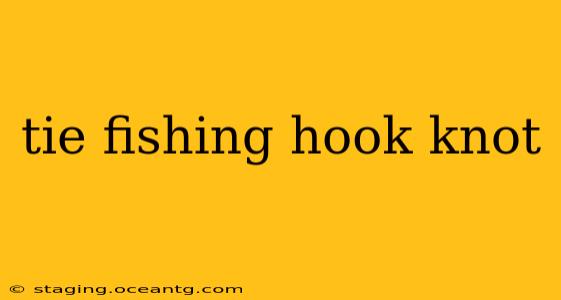Choosing the right fishing hook knot is crucial for a successful fishing trip. A poorly tied knot can mean the difference between landing a trophy fish and watching it swim away. This comprehensive guide will cover several popular and reliable knots, helping you select the best one for your needs and tackle. We'll also address common questions anglers have about tying fishing hook knots.
What are the Best Knots for Tying a Fishing Hook?
There's no single "best" knot, as the ideal choice depends on the type of line, hook size, and the type of fish you're targeting. However, several knots consistently prove reliable and effective. Here are a few top contenders:
-
Improved Clinch Knot: This is arguably the most popular and widely used knot for tying fishing hooks. It's relatively simple to learn, strong, and suitable for most fishing lines and hook sizes.
-
Palomar Knot: Known for its exceptional strength and ease of tying, the Palomar knot is a great all-around choice, especially for heavier lines and larger hooks.
-
Uni Knot: This knot is exceptionally strong and is particularly well-suited for braided lines, though it can be used effectively with monofilament and fluorocarbon as well.
-
Trilene Knot: While less common, the Trilene knot is another strong and reliable option, especially for thinner lines. It’s known for its compact knot size which is beneficial in tighter situations.
How to Tie the Improved Clinch Knot Step-by-Step
The Improved Clinch Knot is a favorite amongst anglers for its simplicity and strength. Here's a step-by-step guide:
- Pass the line through the eye of the hook.
- Wrap the line around the hook shank 5-7 times (more for thicker lines).
- Pass the tag end of the line through the loop formed near the hook eye.
- Moisten the line and pull tightly, ensuring a snug knot.
- Trim the excess tag end close to the knot.
Pro Tip: Always wet your line before tightening the knot to reduce friction and prevent damage.
How to Tie the Palomar Knot Step-by-Step
The Palomar Knot is known for its strength and ease of tying, particularly for larger hooks and heavier lines. Here's how to tie it:
- Double the line and pass it through the eye of the hook.
- Tie a simple overhand knot with the doubled line.
- Carefully slide the loop created over the hook eye.
- Moisten the line and pull both ends of the knot tightly.
- Trim the excess tag end.
How to Tie the Uni Knot Step-by-Step
The Uni Knot excels with braided lines, but is versatile and works with other lines too.
- Pass the line through the hook eye.
- Make 4-6 tight wraps around the line, forming a small coil.
- Pass the tag end of the line through the first coil of the wrap, near the hook eye.
- Moisten the line and pull both the standing line and the tag end tightly.
- Trim the excess tag end.
What is the Strongest Knot for Fishing Hooks?
While the strength of a knot depends on execution, the Palomar and Uni knots are generally considered among the strongest for fishing hooks, particularly when correctly tied. The Improved Clinch Knot is also a strong contender, but its strength is more line dependent.
Which Knot is Best for Braided Line?
The Uni Knot is widely regarded as the best knot for braided line due to its ability to hold exceptionally well on this type of line. However, the Palomar knot is a strong alternative, often favored for its ease of tying.
How Do I Choose the Right Knot for My Fishing Line?
The best knot choice depends heavily on the type of fishing line you're using. Braided lines tend to work best with Uni Knots, whereas monofilament and fluorocarbon lines can perform well with Improved Clinch Knots, Palomar Knots, or Trilene Knots. Experiment to find what works best for you and your specific fishing situation. Remember that proper knot tying technique is paramount regardless of knot choice.
Conclusion
Mastering these knots will significantly improve your fishing success. Practice tying each knot several times until you can tie it quickly and confidently. Remember, a secure knot is essential for preventing lost fish and maximizing your angling enjoyment. Regular practice is key to perfecting your knot tying skills, so keep practicing and happy fishing!
